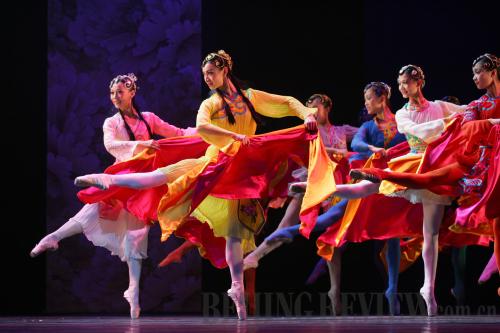|
Entering the 21st century, China's ballet ushered in a flourishing new phase, featuring greater diversity. All kinds of genres appeared, such as dramatic, modern and contemporary, as well as ballet assimilating Chinese cultural elements. Chinese ballet dancers not only successfully present world classical works, but also those new creations of internationally famous contemporary ballet choreographers. A greater amount of communication and cooperation with international ballets has taken place. Foreign choreographers were invited to China quite often, and Chinese choreographers also helped foreign ballets to create ballet works. For example, in 2006, the Royal Danish Ballet invited Wang Yuanyuan, Director of the Beijing Contemporary Dance Theater, to choreograph The Color of Love, the first time the company had commissioned work from a Chinese choreographer.
Are the performance levels of China's ballets strong?
 |
|
Dreaming Red Mansion, Guangzhou Ballet (CFP) |
Although ballet started in China almost three centuries later than in the West, it has developed by leaps and bounds since it was introduced here. Now, China has excellent performance groups, and their comprehensive performance level ranks as the best in Asia. In terms of teaching, China also leads the world. Chinese dancers enjoy a good reputation for solid basic skills. A survey shows that during the past 30 years, Chinese ballet dancers have obtained more than 70 major prizes (gold, silver and bronze) in various world-class ballet competitions, including the Varna International Ballet Competition, known as the ballet Olympics, and the Moscow International Ballet Competition, known as the ballet World Cup.
Now in China there are eight major companies across the country. The National Ballet of China, founded in 1959, the only national ballet of the country, represents the highest level and is undoubtedly the pioneer and main force of Chinese ballet.
The Shanghai Ballet, founded in 1979 based on The White-Haired Girl performing team, stands out among others for its strong Shanghai cultural style in its creations. As Shanghai was the fashion and art capital of China in the 1930s and 40s, the art of dance developed very well there. Besides The White-Haired Girl, the company created many new ballets based on modern Chinese literature, such as Thunderstorm, a ballet drama adapted from the novel of the same name of Cao Yu (1910-96), a great playwright of China. A recent hit of the company was In the Mood for Love, an innovative work inspired by Hong Kong director Wong Kar-Wai's award-winning movie of the same name, in which Chinese qipao was creatively used as the major costume.
The Liaoning Ballet, founded in 1980, is one of the best companies in China. The dancers are well known for their physical condition and shape. The company boasts the best male ballet dancers in China. Representative creations from the company include Butterfly Lovers, adapted from a famous Chinese folk story, and The Last Emperor, a modern historical ballet.
Another major force is the Guangzhou Ballet, founded in 1994. As Guangzhou was a pilot for China's economic reform, new management mechanisms in the company attracted many ballet talents and, at the same time, provided larger space for their creation. Their exploratory works include Mei Lanfang, an innovative work merging ballet with Peking Opera elements, and Dreaming Red Mansion, a modern interpretation of the Chinese literary masterpiece Dream of Red Mansions.
The other major ballets of China are the Tianjin Ballet (founded in 1992), the Suzhou Ballet (founded in 2007), Hong Kong Ballet (founded in 1979) and the newer Beijing Contemporary Dance Theater (founded in 2008). Each of them has strength and uniqueness in performance and creation. Different cultural and dance elements can be seen in their new creations.
Is there still a gap between Chinese ballet and world levels?
In my opinion, creation is a bit weaker in Chinese ballet, when compared with its level of teaching and performance. The major reason for this, I think, is the conceptions of Chinese ballet artists. More or less, most choreographers are still concerned with the creation of dramatic ballet, which focuses on using dance to tell a story. However, on the world ballet stage, modern and contemporary ballet is the mainstream. Full-length ballet drama taking up a whole night has gradually been replaced by collections of shorter works. Normally, there are two or three works a night. Beside this, the creation of new works has tended to be more and more experimental. |
